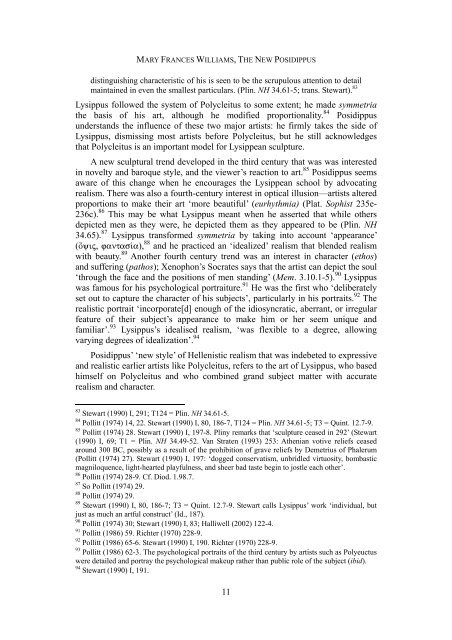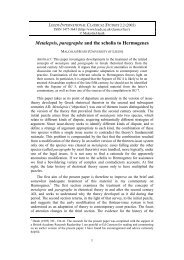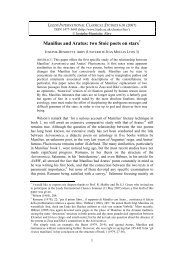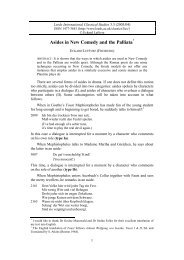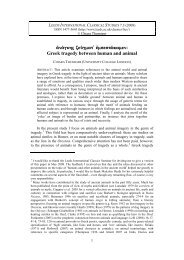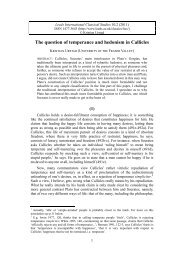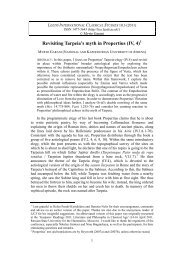The New Posidippus - Leeds International Classical Studies
The New Posidippus - Leeds International Classical Studies
The New Posidippus - Leeds International Classical Studies
Create successful ePaper yourself
Turn your PDF publications into a flip-book with our unique Google optimized e-Paper software.
MARY FRANCES WILLIAMS, THE NEW POSIDIPPUS<br />
distinguishing characteristic of his is seen to be the scrupulous attention to detail<br />
maintained in even the smallest particulars. (Plin. NH 34.61-5; trans. Stewart). 83<br />
Lysippus followed the system of Polycleitus to some extent; he made symmetria<br />
the basis of his art, although he modified proportionality. 84 <strong>Posidippus</strong><br />
understands the influence of these two major artists: he firmly takes the side of<br />
Lysippus, dismissing most artists before Polycleitus, but he still acknowledges<br />
that Polycleitus is an important model for Lysippean sculpture.<br />
A new sculptural trend developed in the third century that was was interested<br />
in novelty and baroque style, and the viewer’s reaction to art. 85 <strong>Posidippus</strong> seems<br />
aware of this change when he encourages the Lysippean school by advocating<br />
realism. <strong>The</strong>re was also a fourth-century interest in optical illusion—artists altered<br />
proportions to make their art ‘more beautiful’ (eurhythmia) (Plat. Sophist 235e-<br />
236c). 86 This may be what Lysippus meant when he asserted that while others<br />
depicted men as they were, he depicted them as they appeared to be (Plin. NH<br />
34.65). 87 Lysippus transformed symmetria by taking into account ‘appearance’<br />
(Ôyij, fantas…a), 88 and he practiced an ‘idealized’ realism that blended realism<br />
with beauty. 89 Another fourth century trend was an interest in character (ethos)<br />
and suffering (pathos); Xenophon’s Socrates says that the artist can depict the soul<br />
‘through the face and the positions of men standing’ (Mem. 3.10.1-5). 90 Lysippus<br />
was famous for his psychological portraiture. 91 He was the first who ‘deliberately<br />
set out to capture the character of his subjects’, particularly in his portraits. 92 <strong>The</strong><br />
realistic portrait ‘incorporate[d] enough of the idiosyncratic, aberrant, or irregular<br />
feature of their subject’s appearance to make him or her seem unique and<br />
familiar’. 93 Lysippus’s idealised realism, ‘was flexible to a degree, allowing<br />
varying degrees of idealization’. 94<br />
<strong>Posidippus</strong>’ ‘new style’ of Hellenistic realism that was indebeted to expressive<br />
and realistic earlier artists like Polycleitus, refers to the art of Lysippus, who based<br />
himself on Polycleitus and who combined grand subject matter with accurate<br />
realism and character.<br />
83 Stewart (1990) I, 291; T124 = Plin. NH 34.61-5.<br />
84 Pollitt (1974) 14, 22. Stewart (1990) I, 80, 186-7, T124 = Plin. NH 34.61-5; T3 = Quint. 12.7-9.<br />
85 Pollitt (1974) 28. Stewart (1990) I, 197-8. Pliny remarks that ‘sculpture ceased in 292’ (Stewart<br />
(1990) I, 69; T1 = Plin. NH 34.49-52. Van Straten (1993) 253: Athenian votive reliefs ceased<br />
around 300 BC, possibly as a result of the prohibition of grave reliefs by Demetrius of Phalerum<br />
(Pollitt (1974) 27). Stewart (1990) I, 197: ‘dogged conservatism, unbridled virtuosity, bombastic<br />
magniloquence, light-hearted playfulness, and sheer bad taste begin to jostle each other’.<br />
86 Pollitt (1974) 28-9. Cf. Diod. 1.98.7.<br />
87 So Pollitt (1974) 29.<br />
88 Pollitt (1974) 29.<br />
89 Stewart (1990) I, 80, 186-7; T3 = Quint. 12.7-9. Stewart calls Lysippus’ work ‘individual, but<br />
just as much an artful construct’ (Id., 187).<br />
90 Pollitt (1974) 30; Stewart (1990) I, 83; Halliwell (2002) 122-4.<br />
91 Pollitt (1986) 59. Richter (1970) 228-9.<br />
92 Pollitt (1986) 65-6. Stewart (1990) I, 190. Richter (1970) 228-9.<br />
93 Pollitt (1986) 62-3. <strong>The</strong> psychological portraits of the third century by artists such as Polyeuctus<br />
were detailed and portray the psychological makeup rather than public role of the subject (ibid).<br />
94 Stewart (1990) I, 191.<br />
11


